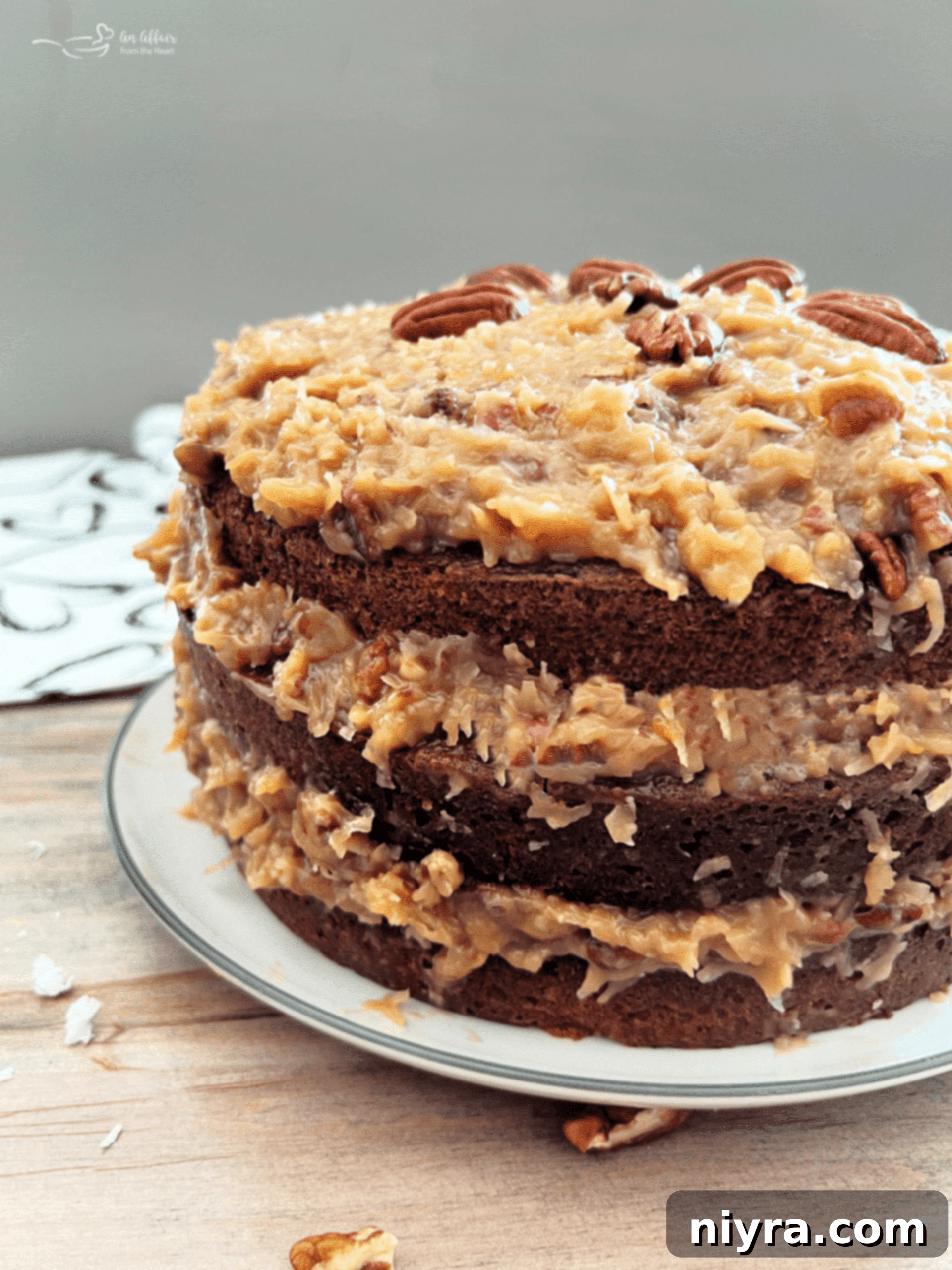Indulge in the ultimate classic dessert experience with this exquisite Homemade German Chocolate Cake Recipe. Forget bland, store-bought versions – this traditional masterpiece delivers pure perfection in every bite. Picture layers of rich, moist chocolate cake generously slathered with a creamy, sweet coconut pecan frosting, all meticulously crafted from scratch. This old-fashioned cake is not just a dessert; it’s an occasion, ideal for satisfying your deepest cravings and elevating any special celebration.

There’s a reason why some recipes become treasured family favorites, and this German Chocolate Cake is certainly one of them. Its soft, buttery texture and intensely satisfying sweetness captivated my family from the very first slice. My journey to this perfect recipe began a little over a year ago when I sought a truly tried-and-true German Chocolate Cake recipe for a dear friend’s birthday. Having previously attempted another recipe for my dad that fell short of expectations, I was determined to find an authentic keeper. And this recipe? It exceeded all hopes and has earned its permanent spot in our dessert repertoire!
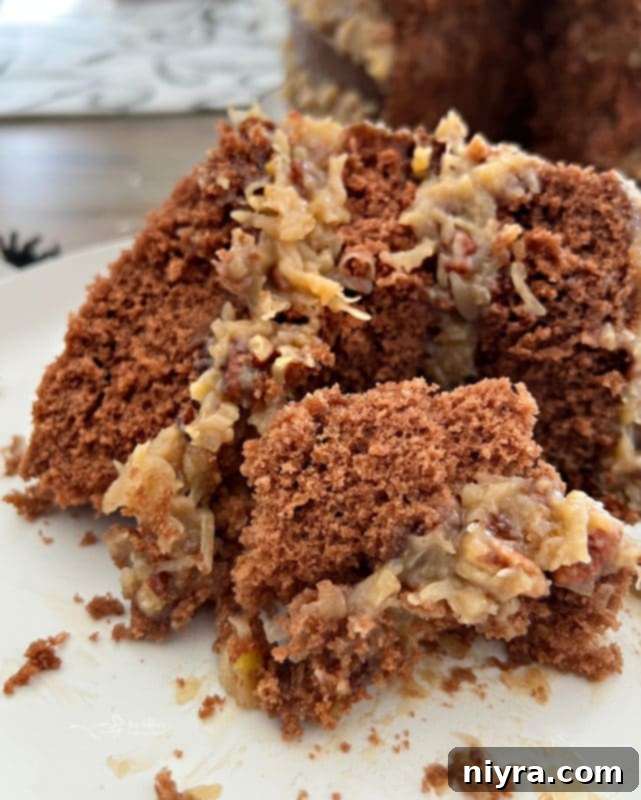
What is German Chocolate Cake?
At its heart, German Chocolate Cake is a beloved, old-fashioned dessert with a rich history spanning decades. Far from being truly German, this iconic chocolate cake earned its name from an American baker named Samuel German, who developed a sweet dark baking chocolate for the Baker’s Chocolate Company in 1852. Hence, it was originally known as “German’s Chocolate Cake.” The qualities that have made this cake a timeless classic remain consistent: a deep, satisfying chocolate flavor balanced by its signature, irresistibly sweet and nutty frosting. It’s characterized by moist, tender chocolate cake layers generously filled and often topped with a unique concoction of sweet shredded coconut and crunchy pecans suspended in a buttery, custardy icing.
What Makes German Chocolate Cake Unique?
The distinction of German Chocolate Cake lies primarily in two key elements. Firstly, unlike many traditional chocolate cakes that rely on dry cocoa powder for their flavor, this recipe typically uses melted German’s sweet chocolate directly in the batter. This imparts a smoother, richer, and often milder chocolate profile that is distinctly different from cakes made with cocoa. Secondly, and perhaps most famously, it features that unmistakable sweet coconut pecan icing. This topping is not a simple buttercream; it’s a cooked custard-like frosting, brimming with shredded coconut and chopped pecans, creating a texture and flavor combination that is instantly recognizable and utterly unforgettable. The visual appeal alone, with its exposed, gooey filling between dark cake layers, sets it apart from other chocolate desserts.

Understanding German Chocolate: Is There a Substitute?
German chocolate, specifically Baker’s German’s Sweet Chocolate, is a crucial ingredient that contributes significantly to this recipe’s authentic taste. It’s notably sweeter than standard bittersweet or unsweetened baking chocolate, yet possesses a milder, less intense cocoa flavor than typical milk or dark chocolate. This unique balance is precisely what allows the cake’s chocolate notes to harmonize beautifully with the sweet, nutty frosting, making the overall flavor truly stand out and incredibly delicious.
While I highly recommend using genuine German chocolate for the most authentic experience, I understand that it may not always be readily available. If you find yourself in a bind, there’s a viable substitute. You can use either semi-sweet or bittersweet chocolate. To compensate for the reduced sweetness, add one-half tablespoon of granulated sugar for every ounce of chocolate required in the recipe. For instance, if the recipe calls for 4 ounces of German chocolate, you would use 4 ounces of semi-sweet or bittersweet chocolate plus 2 tablespoons of sugar.
The Fascinating History: Is German Chocolate Cake Really German?
Despite its name, German Chocolate Cake is not German in origin at all! This delicious cake was actually created in the United States. Its misleading name comes from an American baker named Samuel German, who, in 1852, developed a dark baking chocolate for the Baker’s Chocolate Company. For over a century, this chocolate was simply known as “German’s sweet chocolate.” It wasn’t until a recipe for “German’s Chocolate Cake” appeared in a Dallas newspaper in 1957, submitted by a home baker, that the dessert gained widespread popularity. The recipe was then picked up by General Foods (owner of Baker’s Chocolate) and distributed nationwide. The apostrophe ‘s’ was eventually dropped, leading to the common misconception that the cake originated in Germany. Regardless of its geographic origin, the cake’s addictively sweet and complex flavors have ensured its enduring popularity.
If you’re a true chocolate cake enthusiast, don’t stop here! Be sure to explore some of my other delightful chocolate creations, including my comforting Depression Cake, the sophisticated Chocolate Espresso Bundt Cake, and for the adventurous bakers, my surprisingly delicious Sauerkraut Chocolate Cake!
Key Ingredients for Homemade German Chocolate Cake and Frosting
Achieving the perfect Homemade German Chocolate Cake relies on understanding the role each ingredient plays. You’ll find a complete list of measurements and detailed instructions in the printable recipe card at the very bottom of this post.
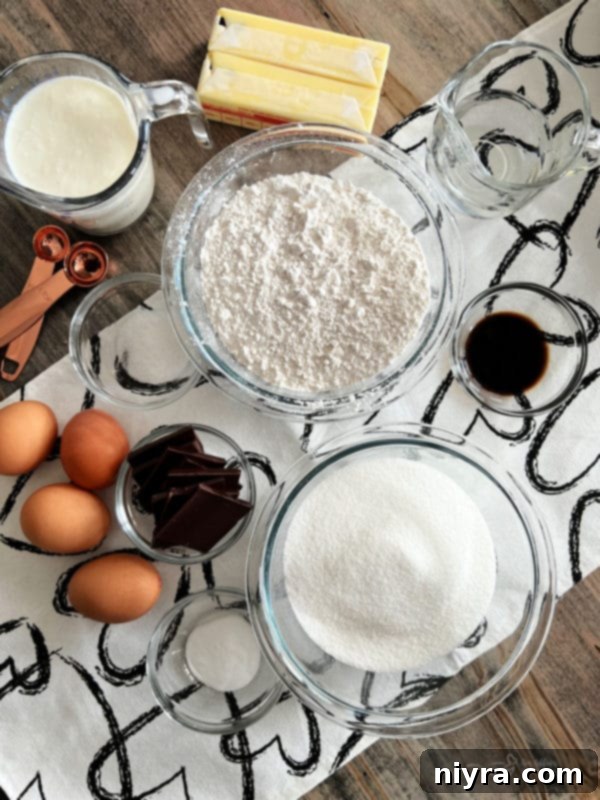
For the Rich Chocolate Cake Layers:
- German Sweet Chocolate: The star of the show. This specific type of chocolate, often found in baking aisles, is ideal because its moderate sweetness and smooth melting properties create a rich, creamy, and distinct chocolate flavor that defines this cake.
- Boiling Water: Used to melt the German chocolate, ensuring it’s smooth and fully incorporated into the batter, contributing to the cake’s moist texture.
- Butter: One cup of softened butter provides a rich, tender base for the cake. Both salted or unsalted butter can be used, just be mindful of adjusting added salt if using salted butter.
- Granulated Sugar: The classic sweetener, ensuring a perfectly balanced sweetness in the cake layers.
- Eggs (Separated): Using both egg whites and yolks, added separately, is a baker’s secret weapon for an incredibly moist and flavorful cake. The yolks add richness and tenderness, while the whipped whites provide essential lift and a delicate crumb.
- Pure Vanilla Extract: Aromatic vanilla is a timeless flavor enhancer, deepening the overall chocolate profile and adding a comforting warmth to the cake.
- Cake Flour: Crucial for achieving the characteristic light, airy, and super soft texture of this cake. Cake flour has a lower protein content than all-purpose flour and is NOT interchangeable for this recipe if you desire the authentic result.
- Baking Soda: The primary leavening agent, working with the buttermilk to ensure the cake rises beautifully and has a tender crumb.
- Salt: A pinch of sea salt is vital for balancing the sweetness and enhancing all the other flavors, as well as activating with the baking soda during baking.
- Buttermilk: This provides a slight tanginess and incredible moisture to the cake without adding extra fat. Its acidity reacts with the baking soda for optimal rise. If you don’t have buttermilk on hand, don’t fret! You can easily make a homemade buttermilk substitute with milk and lemon juice or vinegar. It’s a simple trick I use often.
Once baked, these dark, tender cake layers are ready to be enveloped in the legendary traditional coconut pecan frosting. This frosting, boasting aromatic notes of vanilla, a hint of browned butter, sweet shredded coconut, and satisfyingly crunchy chopped pecans, truly completes what is widely considered the best German Chocolate Cake!
Ingredients to Make the Best Homemade Coconut Pecan Frosting
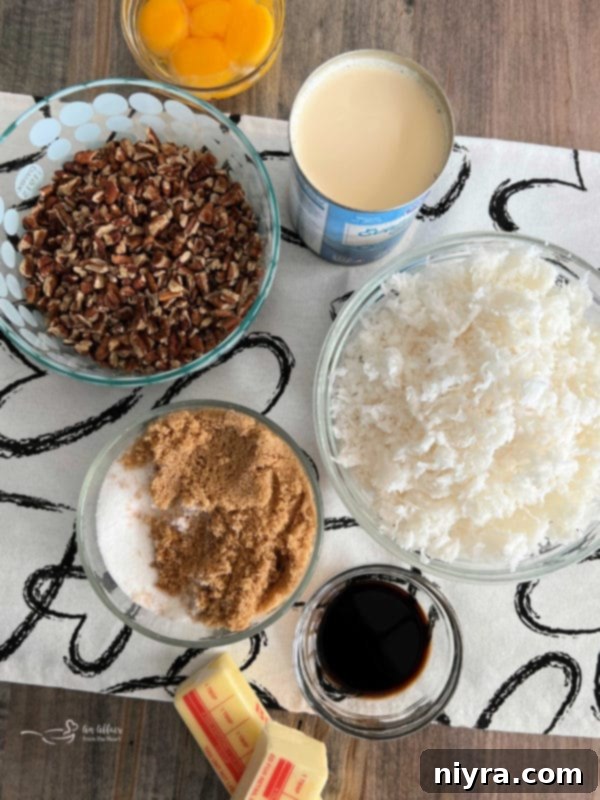
For the Iconic Coconut Pecan Frosting:
- Granulated Sugar & Brown Sugar: The combination of both white and brown sugars is key to the frosting’s depth of sweetness and slightly caramel-like undertones, making it incredibly rich and sweet.
- Evaporated Milk: This shelf-stable, canned cow’s milk has about 60% of its water removed, resulting in a richer, creamier consistency than whole milk. It’s essential for achieving the frosting’s custardy base without adding extra fat.
- Butter: Integral to the frosting, butter contributes to its luxurious creaminess and adds a delightful buttery flavor that balances beautifully with the sugars. The slight saltiness helps cut through the sweetness.
- Egg Yolks: Beaten egg yolks are crucial for thickening the frosting as it cooks, giving it that distinct, smooth, and custardy texture.
- Shredded Sweet Coconut: The defining ingredient for this cake’s unique icing. Sweetened shredded coconut provides essential flavor and texture, infusing every bite with tropical sweetness.
- Chopped Pecans: Adding a delightful crunch and a warm, nutty flavor, chopped pecans are indispensable for an authentic German Chocolate Cake recipe. They perfectly complement the coconut and chocolate.
- Pure Vanilla Extract: Just like in the cake batter, vanilla extract is vital for enhancing the frosting’s overall flavor profile, adding depth and a comforting aroma.
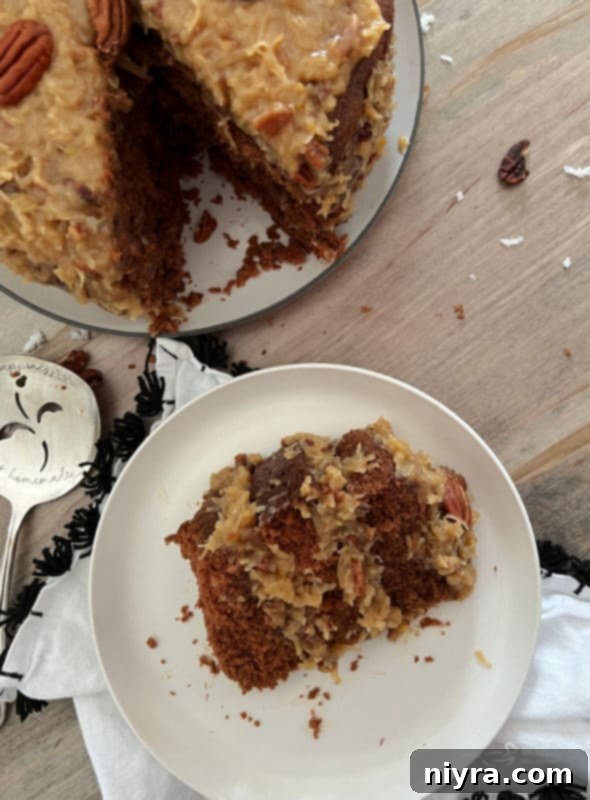
How to Make Traditional German Chocolate Cake from Scratch
Creating this magnificent Traditional German Chocolate Cake from scratch is a rewarding process. Follow these steps carefully to ensure a truly spectacular result.
Step 1: Preparing the Chocolate Base

First, begin by finely chopping the German chocolate into small, uniform pieces. This ensures it melts quickly and evenly. Place the chopped chocolate into a medium-sized, heatproof bowl. Carefully pour the boiling hot water over the chocolate. Allow it to sit for a minute, then gently stir with a spoon or rubber spatula until the chocolate is completely smooth and melted, with no lumps remaining. Set this rich chocolate mixture aside to cool slightly while you prepare the other cake components.
Step 2: Initial Preparation and Pan Prep
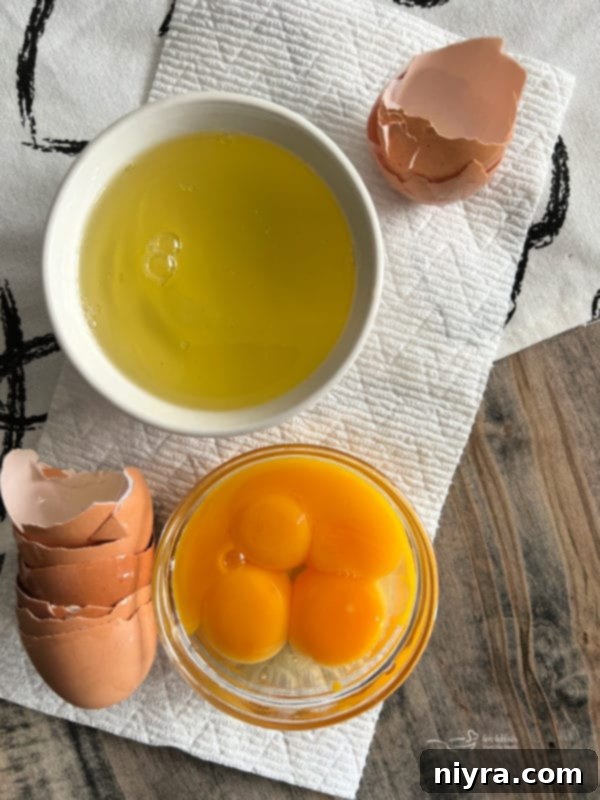
Next, meticulously separate the egg whites from the yolks, placing the egg whites in a clean, separate dish. Ensure no yolk gets into the whites, as this can prevent them from whipping properly. Preheat your oven to 350 degrees Fahrenheit (175°C). Prepare three 9-inch round cake pans by greasing and flouring them thoroughly, or lining the bottoms with parchment paper for easy release. Set these prepared pans aside.
Step 3: Creating the Cake Batter
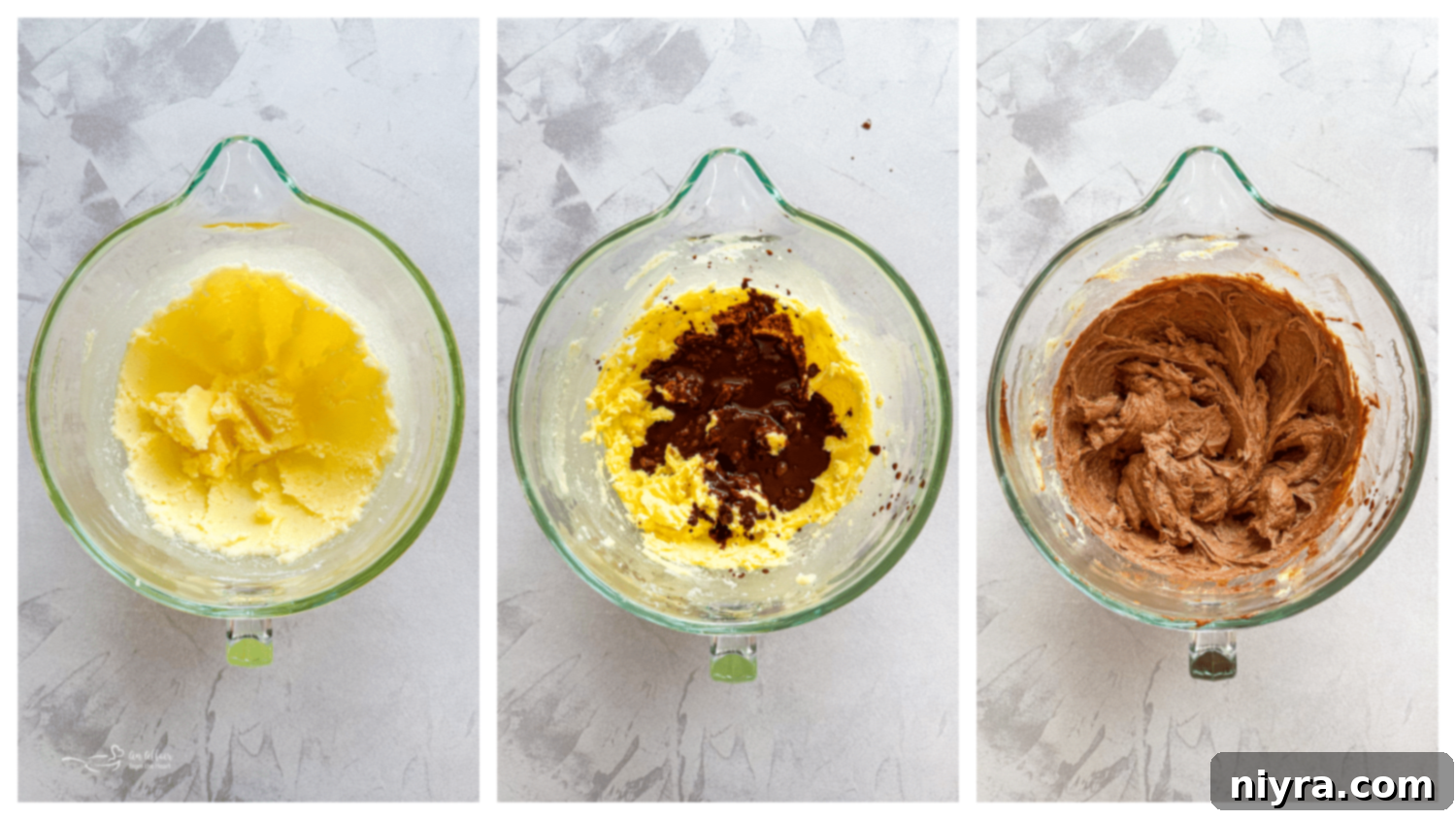
In a large mixing bowl, combine the softened butter and granulated sugar. Using a hand mixer or a stand mixer fitted with the paddle attachment, beat these together on medium-high speed for about 3-4 minutes until the mixture is light, fluffy, and pale in color. Scrape down the sides and bottom of the bowl occasionally to ensure everything is well combined.
Now, add the egg yolks, one at a time, to the butter and sugar mixture. Beat well after each addition until fully incorporated. This gradual addition helps emulsify the batter, creating a smoother texture.
Pour in the cooled melted chocolate and the pure vanilla extract. Mix on low speed until just combined and uniform in color and consistency. Be careful not to overmix at this stage.
In a separate bowl, whisk together the cake flour, baking soda, and salt. Gradually add these dry ingredients to the wet ingredients, alternating with the buttermilk. Begin and end with the dry ingredients. Mix on low speed, just until the ingredients are combined and no streaks of flour remain. Overmixing will develop the gluten in the flour, resulting in a tough cake.
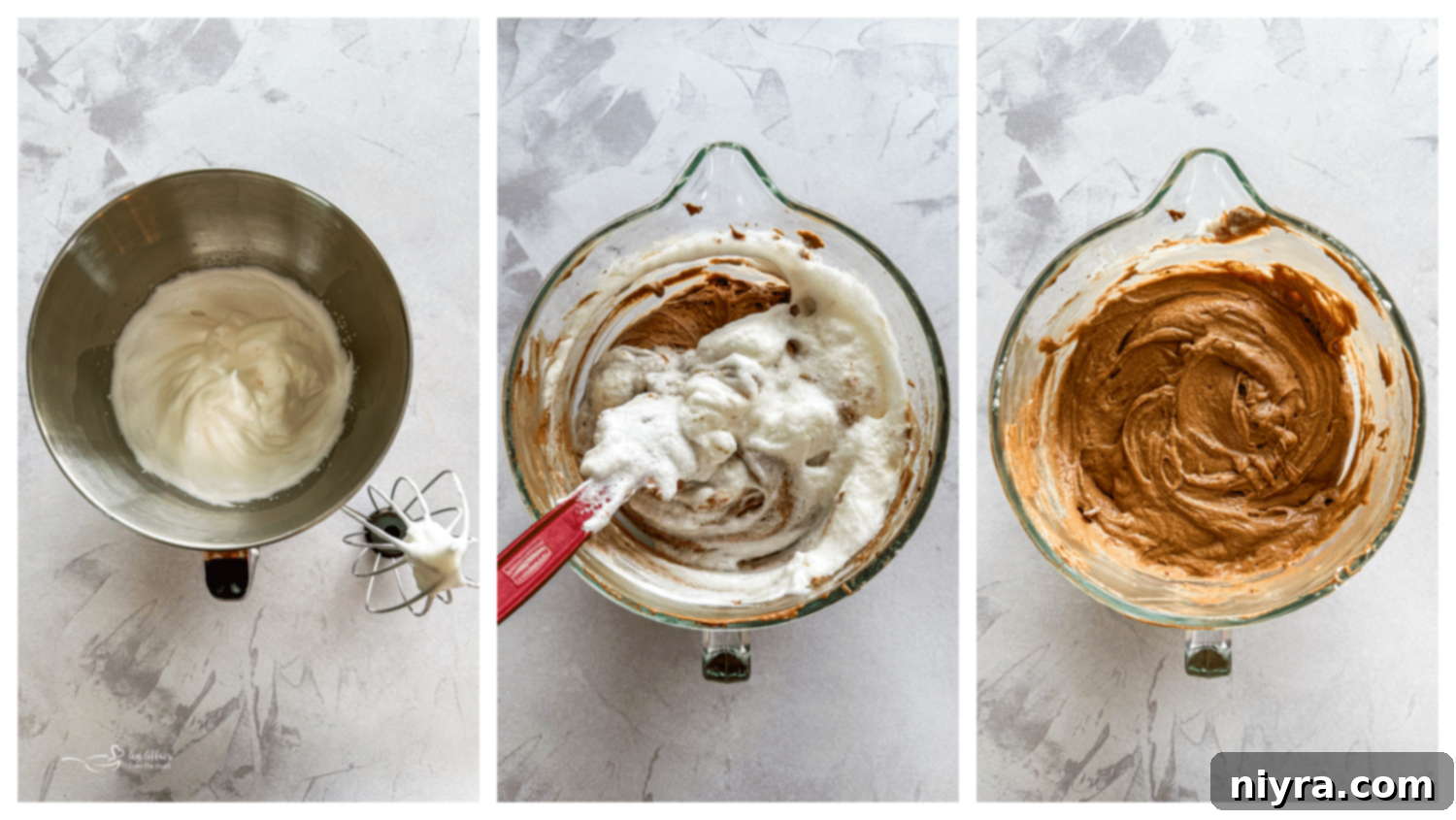
In a separate clean bowl, using the whisk attachment of your stand mixer or a hand mixer, beat the reserved egg whites until stiff peaks form. Gently fold these whipped egg whites into the prepared cake batter in two or three additions. Use a rubber spatula and a delicate, lifting motion to preserve the air in the whites, which gives the cake its light texture. Fold until just combined, being careful not to deflate the batter.
Step 4: Baking the Cake Layers

Evenly divide the chocolate cake batter among the three prepared cake pans. Ensure the batter is distributed as equally as possible for even baking.
Bake the cake layers in the fully preheated oven for 24 to 28 minutes. Baking times can vary, so begin checking around the 22-minute mark. The cakes are done when a wooden toothpick inserted into the center of each cake comes out clean or with only a few moist crumbs attached.

Once baked, remove the cake pans from the oven and allow the cakes to cool in their pans on a wire rack for at least ten minutes. This resting period helps the cakes firm up and prevents them from breaking when transferred. After ten minutes, carefully invert the cakes onto the wire racks to cool completely. They must be entirely cool before frosting to prevent the frosting from melting.
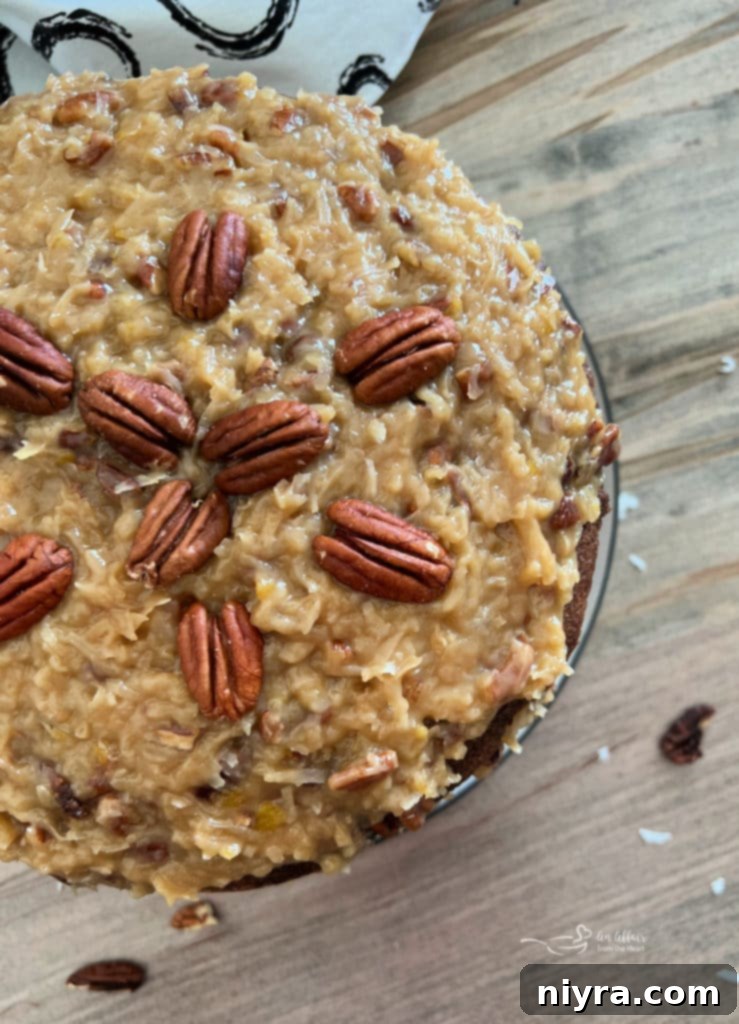
Preparing Homemade Coconut Pecan Frosting for German Chocolate Cake
The iconic frosting is what truly elevates this German Chocolate Cake. Follow these steps for a luscious, perfect consistency.
Step 5: Cooking the Custard Frosting
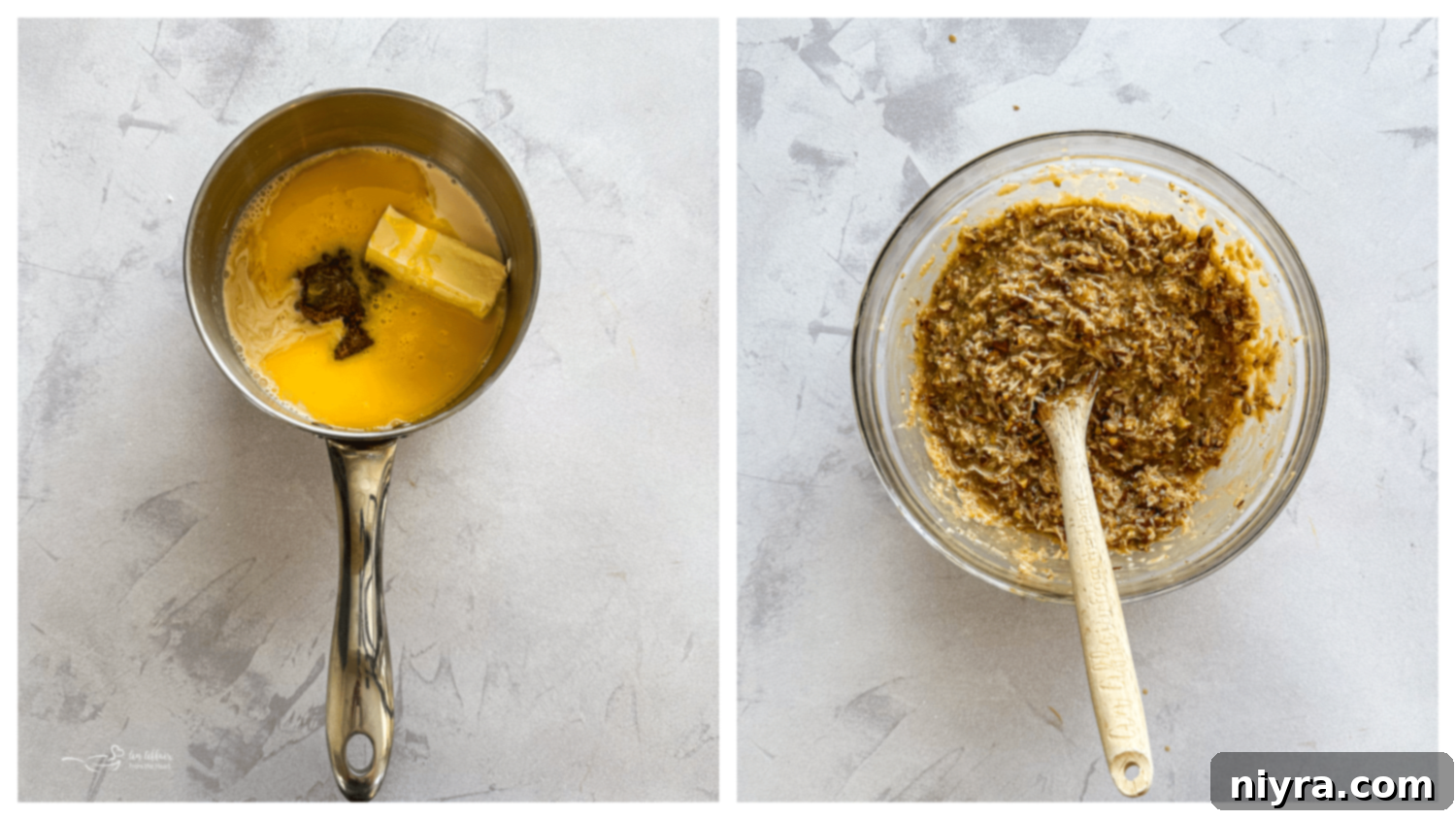
In a medium saucepan, combine the granulated sugar, brown sugar, evaporated milk, butter, and the beaten egg yolks. Place the saucepan over medium heat. Cook the mixture, stirring constantly with a whisk or rubber spatula, to prevent the eggs from scrambling and the mixture from sticking to the bottom. Continue cooking until the frosting thickens to a custard-like consistency and turns a beautiful golden brown color. This typically takes about 5-7 minutes. The constant stirring is key to a smooth, creamy frosting.
Once thickened, remove the saucepan from the heat. Stir in the pure vanilla extract, chopped pecans, and shredded sweetened coconut. Mix everything together until well combined. Allow the frosting to rest and cool for at least 30 minutes. As it cools, it will continue to thicken and reach the perfect spreadable consistency.
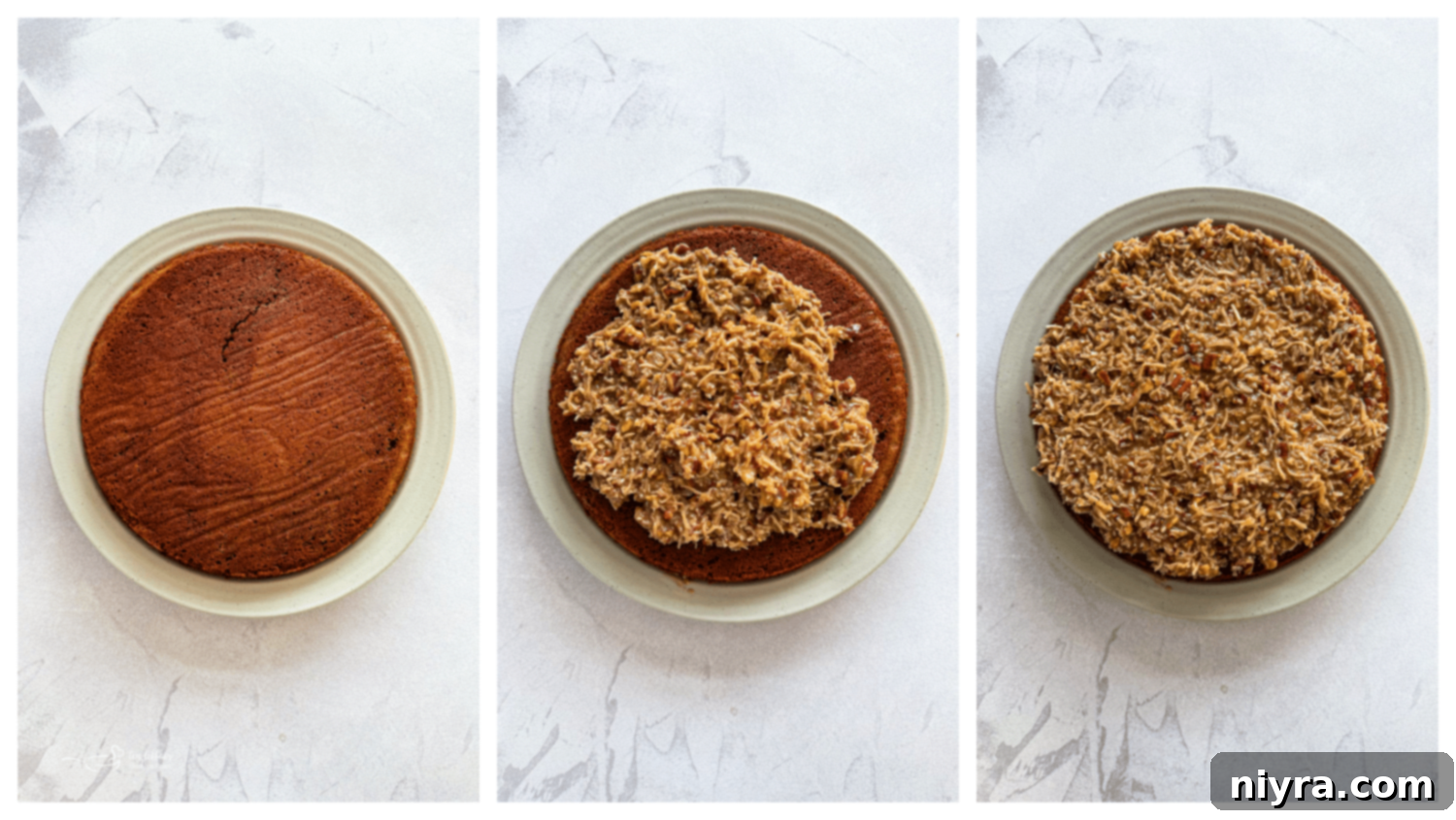
Step 6: Assembling the German Chocolate Cake
Finally, it’s time to bring all the delicious components together. Place the first cooled cake layer onto your chosen cake plate or stand. Evenly spread approximately one-third of the prepared coconut pecan frosting over the top of this layer. Place the second cake layer on top and repeat the frosting process, using another third of the frosting. Finish by placing the third cake layer on top and spreading the remaining frosting across its surface. For a traditional “naked cake” look, the sides are left bare, beautifully showcasing the moist chocolate layers and gooey frosting.
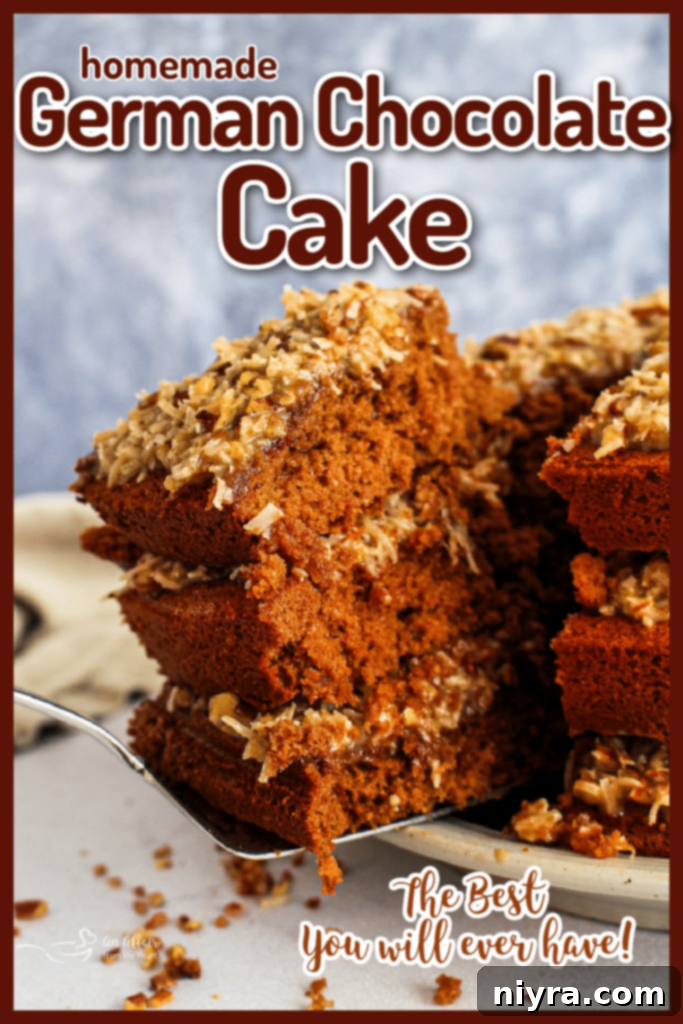
Note: This recipe yields enough frosting for a cake with exposed sides (a “naked cake” style). If you prefer to frost the entire exterior of the cake, including the sides, you will need to double the frosting recipe.
Love It? Pin It!
Don’t let this incredible chocolate cake disappear into the digital abyss! Be sure to save this exceptional recipe to your favorite dessert board on Pinterest. Whether it’s for upcoming holidays, a special birthday party, or any event demanding a truly decadent dessert, pinning this homemade German Chocolate Cake recipe will ensure you can quickly find it the next time you crave a sweet, nutty, and utterly delicious slice of perfection!
Why This Traditional German Chocolate Layer Cake is the Absolute Best
This Homemade German Chocolate Cake stands as an old-fashioned original cake recipe, celebrated for its perfect harmony of sweet German chocolate and luscious, nutty frosting. You’ll fall in love with it for numerous compelling reasons:
- Surprisingly Easy to Make: Despite its impressive appearance, this traditional German cake is crafted with straightforward steps that are easy to follow, even for novice bakers. You’ll feel a immense sense of accomplishment and pride once you unveil your creation. While it’s tempting to keep every crumb for yourself, you’ll want to share its magic! Just ensure all ingredients are properly measured before you start for the best possible results.
- Rich and Incredibly Moist: Prepare for a sensory delight. The harmonious blend of creamy German chocolate layers, the sweet coconut pecan frosting, fragrant vanilla extract, rich butter, and perfectly balanced sugars creates an extraordinarily moist, homemade cake. Each bite is an explosion of intense, delectable flavors that dance on your palate.
- Undeniably the Best Cake You’ll Ever Eat: I assure you, this is not an exaggeration. This truly is the best German Chocolate Cake you will ever experience. The irresistible, sticky-sweet layers and the generous coconut pecan filling not only provide incredible flavor but also contribute to the cake’s exceptional texture. The cake layers absorb some of the homemade icing’s moisture, making it incredibly spongy and tender. The use of real melted German chocolate, rather than just cocoa, is the secret ingredient that transforms this from a good cake into a truly wonderful, memorable dessert.
- Perfect for Any Occasion: This easy-to-make chocolate layer cake is the ideal centerpiece for any traditional gathering. Birthdays, holidays, anniversaries, or simply a weekend treat – everyone will adore this homemade cake recipe. Its classic appeal guarantees it will be a crowd-pleaser and a conversation starter.
FAQs About Storing German Chocolate Cake from Scratch
- How long does German Chocolate Cake Made from Scratch keep? The cake layers and frosting have different storage durations. You can prepare the coconut pecan frosting up to a week in advance and store it in an airtight container in the refrigerator. Before using, simply let it come to room temperature on the counter and give it a good stir to restore its creamy texture. The assembled cake itself will last fresh for about 2-3 days at room temperature in an airtight container, or significantly longer in the refrigerator.
- Can German Chocolate Cake be Frozen? Absolutely! Both the frosting and the baked cake layers freeze exceptionally well. For best results, I recommend slicing the cake into individual servings. Wrap each slice securely in plastic wrap, then place them in an airtight freezer-safe container. Cake layers can be frozen for up to three months. To freeze the frosting, transfer it to an airtight storage container and freeze for up to three months. Always allow the frosting to thaw completely to room temperature before attempting to spread it onto your cake.
- Do you have to refrigerate German Chocolate Cake? While it’s not strictly necessary, refrigerating the cake significantly extends its freshness. Stored in an airtight container, your German chocolate cake will remain fresh in the fridge for approximately 4-5 days. If kept at room temperature in an airtight container, it’s best enjoyed within 2-3 days for optimal taste and texture.
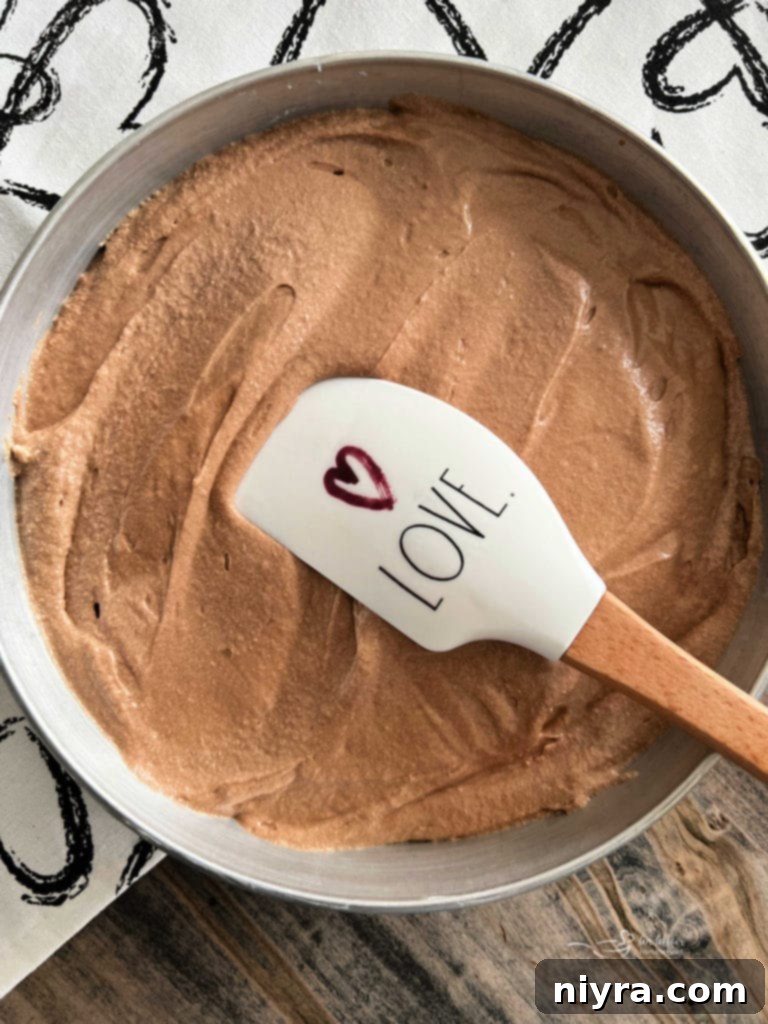
Expert Tips for Making the Best German Chocolate Cake
Achieve bakery-quality results with these crucial tips for your Homemade German Chocolate Cake:
- Use Cake Flour, Not All-Purpose: This is perhaps the most important tip. Cake flour has a lower protein content, which results in a much finer, softer crumb compared to all-purpose flour. Substituting it will significantly alter the cake’s delicate texture.
- Room Temperature Ingredients are Key: Ensure your eggs and butter are at room temperature before you begin. This allows them to emulsify properly, creating a smoother batter and a more uniform, tender cake.
- Locating German Chocolate: Don’t stress about finding this special ingredient! You should be able to find German chocolate bars or baking pieces in the baking aisle of most major grocery stores.
- Avoid Overmixing the Cake Batter: Once you’ve added the dry ingredients and buttermilk, mix only until just combined. Overmixing develops gluten, leading to a tough, dense cake that won’t rise as beautifully. Beat the butter and sugar until very light and fluffy, but treat the subsequent additions gently.
- Semi-Sweet Chocolate as a Substitute: As mentioned, if true German chocolate is unavailable, semisweet chocolate can be used. Just remember to add an additional 1/2 tablespoon of granulated sugar for every ounce of semisweet chocolate to balance the sweetness. However, for the most authentic flavor, always prioritize using German chocolate if you can find it.
- Cool Cakes Completely: Ensure your cake layers are absolutely cool before applying the frosting. Warm cakes will cause the frosting to melt and slide off, creating a messy result.
- Don’t Rush the Frosting Cooling: The coconut pecan frosting needs its full cooling time (at least 30 minutes) to thicken to the correct consistency. Rushing this step will result in a runny frosting that won’t hold between the layers.
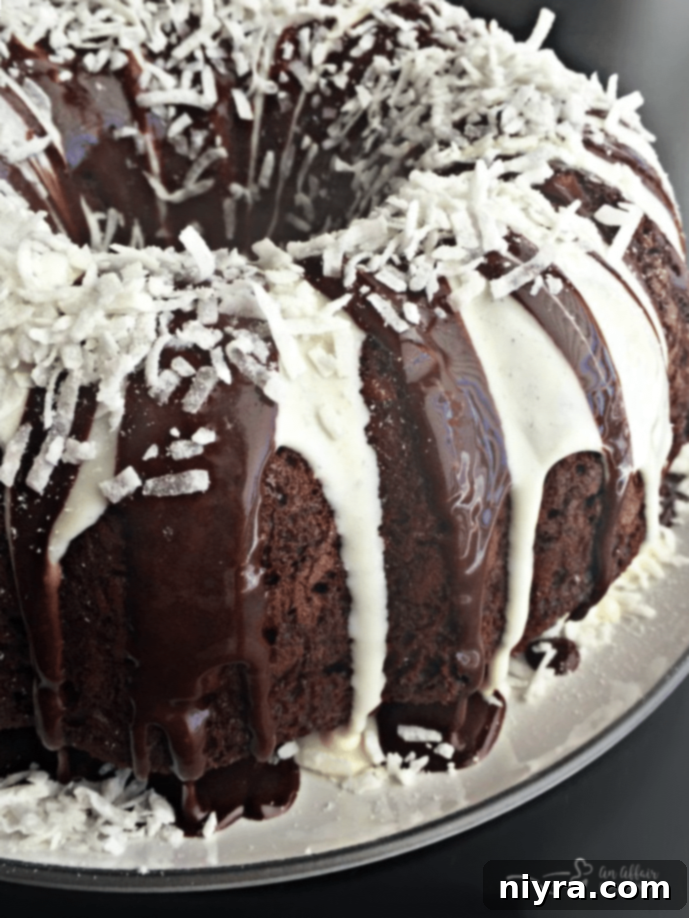
More Irresistible Cake Recipes to Love
If you’ve fallen for the charm of this Homemade German Chocolate Cake, you’ll surely enjoy exploring these other delightful cake recipes:
- Coconut Macaroon Tunnel Cake (pictured above)
- Black Forest Cake
- Fresh Apple Cake
- Easy Lemon Raspberry Bundt Cake
- Strawberry Cake
- Apple Kuchen (German Apple Cake)
- Carrot Bundt Cake
- Zwiebelkuchen (German Onion Pie – a savory treat!)
- German Apple Dessert
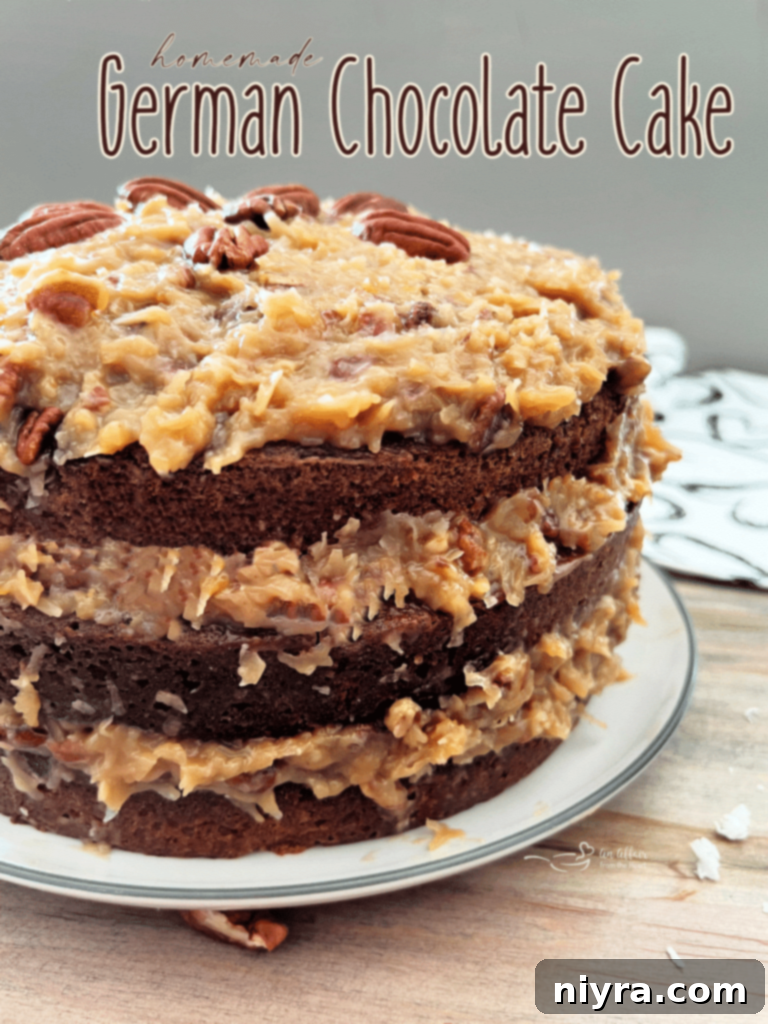
I genuinely can’t wait to hear your thoughts and experiences with this Homemade German Chocolate Cake! Share your baking triumphs and any modifications you make – I love hearing from you.

LIKE THIS RECIPE?
Don’t forget to give it a ⭐️⭐️⭐️⭐️⭐️ star rating and
leave a comment below the recipe!
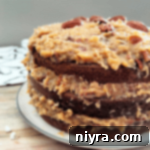
Print Recipe
The BEST German Chocolate Cake
This traditional Homemade German Chocolate Cake Recipe is simply perfection. Layers of creamy, sweet coconut pecan frosting nestled between rich chocolate cake, all made completely from scratch. This old-fashioned cake recipe is the ideal dessert for all your cravings and special occasions.
20 mins
30 mins
30 mins
1 hr 20 mins
Equipment
- Zyliss Comfort Utility Knife
- Offset Spatula Set (6, 8, 10 Inch Stainless Steel Blades)
- Rubber Spatulas
- Kitchenaid Stand Mixer
- Baker Eze 9″ Round Cake Pan, Set of 4
Ingredients
- FOR THE CAKE:
- 4 ounces German sweet chocolate chopped
- ½ cup boiling hot water
- 1 cup butter softened
- 1 ¾ cups sugar
- 4 eggs room temperature, divided
- 2 teaspoons pure vanilla extract
- 2 ½ cups cake flour
- 1 teaspoon baking soda
- ½ teaspoon salt
- 1 cup buttermilk
- FOR THE FROSTING:
- ¾ cup granulated sugar
- ¾ cup brown sugar
- 12 ounces evaporated milk
- ¾ cup butter
- 5 large egg yolks room temperature, beaten
- 3 cups shredded sweetened coconut
- 1 ½ cups chopped pecans
- 1 Tablespoon pure vanilla extract
Instructions
- Preheat the oven to 350 degrees F (175°C). Grease and flour three 9-inch round cake pans or line with parchment paper for easy release. Set aside.
- To a medium-sized bowl, add the chopped German chocolate. Pour the boiling hot water over the chocolate and stir gently until it is melted and smooth. Set aside to cool slightly.
- Using your stand mixer or hand mixer, cream softened butter and granulated sugar together for about 4 minutes, until light and fluffy. Scrape the sides and bottom of the bowl about halfway through.
- Separate egg whites from yolks, reserving the egg whites in a clean bowl. Add each of the yolks, one at a time, to the butter and sugar mixture, mixing well after each addition until fully incorporated.
- Add in the pure vanilla extract and the slightly cooled melted chocolate. Mix until combined and uniform. Scrape the sides and bottom of the bowl and mix again briefly.
- In a separate bowl, whisk together the cake flour, baking soda, and salt. Add these dry ingredients to the wet mixture alternately with the buttermilk, beginning and ending with the dry ingredients. Mix only until just combined, being careful not to overmix. Scrape the sides of the bowl after each addition.
- Beat the reserved egg whites until stiff peaks form. Gently fold these whipped egg whites into the cake batter in 2-3 additions until just combined, taking care not to deflate the batter.
- Divide the cake batter evenly between the three prepared 9-inch round cake pans. Bake for 24-28 minutes, or until a wooden toothpick inserted into the center of the cakes comes out clean. Cool slightly in the pans for at least 10 minutes before inverting onto wire racks to cool completely.
- For the frosting: In a medium saucepan, combine the granulated sugar, brown sugar, evaporated milk, butter, and beaten egg yolks. Cook over medium heat, stirring constantly, until the frosting thickens and turns a golden brown color (about 5-7 minutes). Be sure to stir constantly to prevent the eggs from scrambling. Remove from heat and stir in the pure vanilla extract, shredded coconut, and chopped pecans. Cool for at least 30 minutes. The frosting will continue to thicken as it cools.
- To assemble the cake: Place the first cooled cake layer on a cake plate. Spread ⅓ of the prepared frosting evenly over the top. Repeat with the next two layers, leaving the sides of the cake bare for a traditional “naked” look.
Notes
- If you wish to frost the entire exterior of the cake (including the sides), you will need to double the frosting recipe.
- No buttermilk? Try this easy Buttermilk Substitution for a homemade solution.
- To Freeze leftovers: Slice the cake into individual servings, then wrap each slice securely in plastic wrap before placing into an airtight container. Cake layers can be frozen for up to three months.
- Store the assembled cake at room temperature in an airtight container for up to 3 days, or in the refrigerator for up to 1 week for extended freshness.
Nutrition
This recipe was originally posted on February 18, 2022, as part of a blog hop called Freaky Friday. It has been thoroughly updated to improve user experience and reshared on January 27, 2025.

A Culinary Collaboration: The Freaky Friday Blog Hop
While I’ve poured my heart into perfecting and presenting this recipe, I must give credit to its original inspiration. This German Chocolate Cake recipe was my cherished contribution to a past winter round of the Freaky Friday blog hop! For that particular event, I had the delightful assignment of exploring House of Nash Eats, a wonderfully engaging blog curated by the incredibly sweet and talented Amy Nash.
Amy’s blog and mine share a kindred spirit in terms of culinary tastes and recipe philosophy. Much like my approach, she focuses on sharing tried-and-true family recipes that are both comforting and delicious. It was a true pleasure to delve into her collection, and I found it challenging to pick just one recipe to feature for our hop.
I highly encourage you to explore more of Amy’s fantastic creations, such as her hearty Wisconsin Cauliflower Soup, the exquisite Miso Salmon, and her vibrant Layered Rainbow Jello! Take some time to browse her website – I’m confident you’ll agree that her recipes are truly inspiring and her blog is a treasure trove for home cooks.
